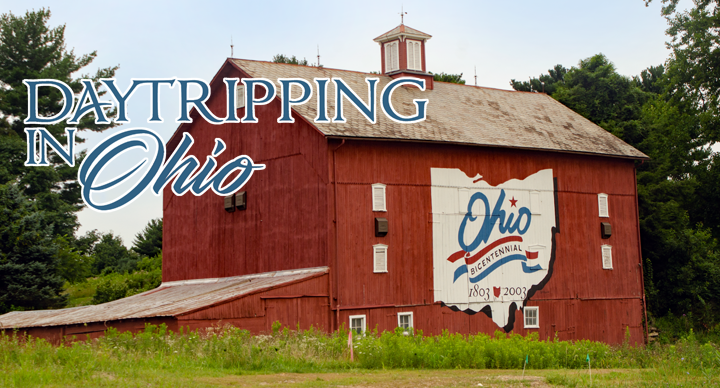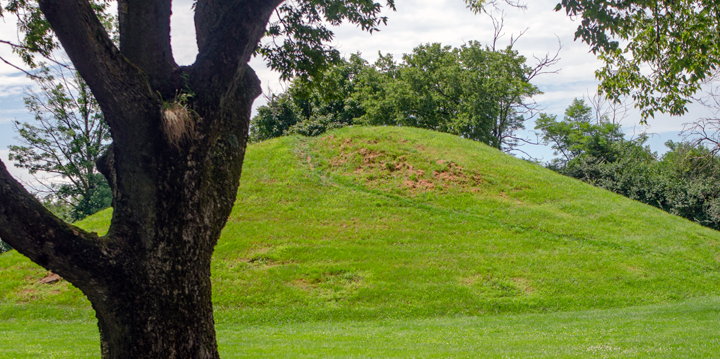When I lived in Antwerp, Belgium, the oldest house in the city was built in the 1500s! That kind of history makes most things in the United States seem so quaint and new. However, there is rich Native American history throughout the continent -- including in Ohio -- that predates anything in Colonial America. That fact should be obvious with a name like Ohio coming from the Seneca people.
So, I decided to do a little daytripping in Central Ohio to see what I could explore. I started with some Native American sites and then expanded. I'd still rather tour a cathedral in Europe, head out into the remote bush in Africa, discover kangaroos in Australia, or wander Inca ruins in South America, but I was very pleasantly surprised what the land of that great river had to offer.
 My little artsty-fartsy photo at Shrum Mound
My little artsty-fartsy photo at Shrum Mound Both the Adena and Hopewell people were hunters and farmers. They would hunt wild game, birds, and fish. They would have grown squash, gourds, beans, sunflowers, and corn. The Adena were known to trade with other tribes in what would become the Central, South, and Southeast United States. The Hopewell expanded trade to get obsidian from the Rocky Mountains, sea shells from the Gulf of Mexico, sharks teeth from Chesapeake Bay, and copper from the Great Lakes.
The Adena, as well as the Hopewell, were famous for the mounds that they built. Some of the mounds were burial grounds. Others were ceremonial effigy mounds shaped like various animals. Perhaps the most famous of these is the Great Serpent Mound near the Ohio River. This mound, shaped like a coiled snake, is three feet tall and 1,348 feet long. Estimates say that it is probably 2,000 years old.
When settlers first came into the region, there were thousands of mounds in all sizes. Most of them did not survive the passage of time. Today, it is possible to visit about 70 different mound locations in Ohio. There is one small mound in a local park that is very close to where I live. It's in the middle of a woods, about six feet tall, and covered with brush. There is no way to photograph it well. I didn't even try. Instead, I headed out to Shrum Mound on the other side of town. It is about 20 feet tall with a diameter of 100 feet and one of the last conical mounds still in Columbus. It is believed to be 2,000 years old and built by the Adena people. More importantly to me, it is beautifully landscaped and so easy to photograph.
Accommodation really wasn't all that well accepted by many of the Native Americans, especially with the Shawnee leader Tecumseh and his brother Tenskwatawa. In an attempt to stop the flow of Europeans and Americans into their territory, Tecumseh gathered a confederacy of multiple tribes in war against the United States. The war didn't go well for Tecumseh. (He was killed in 1813.) It didn't go well for his warriors either.
Tenskwatawa (the brother) was a Shawnee religious leader known as the Prophet. He was no fan of Leatherlips either. After Leatherlips sold land to the settlers, Tenskwatawa called for his death! And, if selling the land wasn't reason enough to kill the guy, the Prophet also accused his foe of witchcraft. It was another Wyandot chief, Leatherlips' own brother Roundhead, who finally declared the death penalty.
A kill squad of six Wyandot warriors headed out to Dublin to find Leatherlips. The old man, now nearly 80 years old, had some settlers plead for his life. The warriors were not moved. Then, they did the next logical step. The settlers tried to bribe the warriors. That didn't work either! Inconceivable! Eventually, Leatherlips dressed in his finest clothing, sang a death chant, and then said a prayer. When all the preparations were completed, one of the warriors reached for his tomahawk.
Dublin is one of the bedroom communities of Columbus. It's the home of Scioto Park, overlooking the Scioto River. The park is 218 acres set up for play, hiking trails, boating, and fishing. And, when I went to visit, there was a concert in full swing.
I'd driven past the park before without even realizing it was a park and certainly not seeing the 12 foot tall limestone statue of Leatherlips' face! The park rolls down from the main road to the river below. Out of view of any drivers, the sculpture gracefully looks down on the water below. I can't say it was peaceful, because that concert was really loud, but it was certainly elegant. I was very impressed that any artist could have imagined creating such a sculpture out of slabs of rock. I think it would bring a smile to Leatherlips' lips. I know it did to mine.
I counted the number of corncobs, but I wasn't accurate. I came up with 106, but there were three more of them. Each corncob is made of white cement, stands just over six feet tall, and weighs 1,500 pounds. The project was commissioned by the Dublin Arts Council and the ears were designed by Malcolm Cochran, a professor of sculpture at THE Ohio State University. For those who just have to know, originally three differing ears were cast and then molds were taken of each ears. When the corncobs were installed, the ears were turned at various angles to give the illusion that every ear is unique.
The instillation was designed to honor Ohio's rich corn heritage. The field where the corncobs are on display was once an actual cornfield. That comes as no surprise because so much of the land around Columbus, Ohio, used to be farmland (including where I live). In fact, this particular park was farmed by Sam Frantz from 1935 to 1963. Frantz also worked with THE Ohio State University developing hybrid corn seeds on this very property! The double-cross hybrid variety of corn that Cochran used for his design is called Corn Belt Dent Corn (which is probably more information than you needed to know.)
The biggest surprise to me as I learned about corn was that fact that it has been cultivated in Ohio for approximately 1800 years! And, it wasn't just grown in small little garden patches around tepees, wigwams, and longhouses. By the mid-1700s, in the Scioto River Valley (from around Columbus and south to the Ohio River) and in the Miami River Valley (from Dayton to Cincinnati), thousands of acres of cornfields were grown. Thousands! Who knew?
The farming continued when the European and American settlers came to Ohio in the late 1700s. Corn was their most important crop. It was food for the family as well as the livestock and any surplus was sold. By 1850, Ohio led the nation with its corn production. Franklin County, where Columbus is located, was once one of the leading corn-producing areas in the state. As the capitol city continues to sprawl in all directions, that is no longer the case.
And, on a very personal note, the big festival every year where I grew up was the Wyandot Popcorn Festival. It's actually the world's largest popcorn festival and annually draws a crowd of about 250,000 people. When I attended in the past, I had no idea that the Wyandot people actually grew corn. I still can't imagine Indians sitting around the fire eating popcorn (but with a little research, I learned that that was exactly what they did!) And, I also had no idea that in the years since I moved away, the entertainment at the Popcorn Festival included Lee Greenwood, the Righteous Brothers, the Pointer Sisters, the Commodores, Willie Nelson, Kansas, Kool and the Gang, Ricki Martin, Blake Shelton, Boyz II Men, and the Village People. I'm a little shocked.
So, lesson learned in my daytripping. No matter where you live, if you do a little research, you might be surprised what you find in your own backyard. And, if you get up early when the light is just right for photography, you may have a good morning in Ohio, or wherever you find yourself.





 RSS Feed
RSS Feed